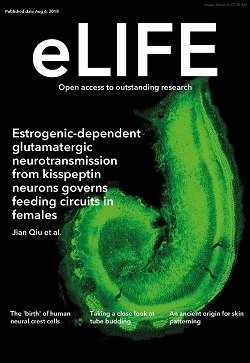
Qiu et al. eLife 2018;7:e35656eLife 2018;7:e35656 eLife 2018;7:e35656 DOI:
Elife article
Hypothalamic kisspeptin neurons are essential for sexual development (puberty) and reproduction and may also be involved in other vital functions like feeding. There are two groups of kisspeptin neurons: One in the rostral forebrain that is stimulated (excited) by the female sex hormone estradiol, and another group in the arcuate nucleus of the hypothalamus, located immediately above the pituitary gland, which is believed to be inhibited by estradiol. The arcuate kisspeptin neurons co-localize the neuropeptides kisspeptin, neurokinin B and dynorphin, which are known to regulate synchronized neuronal firing leading to pulsatile release of gonadotropin-releasing hormone (GnRH) from the hypothalamus and luteinizing hormone (LH) from the pituitary gland. The pulsatile release of these hormones is essential for reproduction. Arcuate kisspeptin neurons also co-localize the classical neurotransmitter glutamate, but essentially nothing is known about the role of glutamate or estradiol regulation of glutamate release from arcuate kisspeptin neurons.
Using a technique called optogenetics combined with electrophysiology and molecular profiling of kisspeptin neurons, we found that estradiol in females, in contrast to testosterone in males, increased the mRNA levels of vesicular glutamate transporter (a measure of glutamate packaging in vesicles) and the release of glutamate from arcuate kisspeptin neurons. These findings documented that there is a significant male versus female difference in glutamate neurotransmission from arcuate kisspeptin neurons and that glutamate is regulated differently than the neuropeptides (down regulated by estradiol) in females. We also found that with higher activity of arcuate kisspeptin neurons more glutamate is released, which activates different metabotropic glutamate receptors in proopiomelanocortin (POMC) than in neuropeptide Y/agouti related peptide (NPY/AgRP) neurons. Thus, glutamate excites POMC neurons but inhibits NPY neurons with the net result of inhibiting food intake in females. We next prepared animals in which synaptic release of glutamate was eliminated from kisspeptin neurons and measured the effects on feeding behavior when females were given access to normal low fat diet as compared to more palatable food. Although animals lacking glutamate in kisspeptin neurons did not show overt weight gain on a normal diet, these females showed clear preference for palatable food as compared to normal controls, an indication that estradiol-stimulated glutamate release from kisspeptin neurons may be important for dampening the desire for calorie-rich food in females.
Since females are prone to eating disorders and body weight gain, particularly during hypo-estrogenic states, these results could lead to development of targeted strategies to counter eating disorders in women.